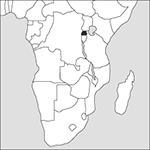
Source: MAPS IN MINUTES™ © RH Publications (1997)
Capital:
Kigali
Area:
26,338 sq km (10,169 sq miles)
Population:
12,012,589 (2013 est)
Currency:
1 Rwanda franc = 100 centimes
Religions:
Roman Catholic 49.5%; Protestant 39.4%; other Christian 4.5%
Ethnic Groups:
Hutu 84.0%; Tutsi 15.0%; Twa 1.0%
Languages:
Kinyarwanda, French, English (all official); Swahili
International Organizations:
UN; AU; Non-Aligned Movement; WTO; Commonwealth
A small country in east central Africa. It is bounded in the west by the Democratic Republic of Congo and Lake Kivu, on the north by Uganda, on the east by Tanzania, and on the south by Burundi.
Physical
Rwanda occupies a mountainous region where the equatorial climate is modified by the altitude. Set on the eastern edge of the Great Rift Valley, at the head of Lake Tanganyika, it is also volcanic.
Economy
Rwanda is one of the poorest countries in the world. It has the highest population density in Africa, with the great majority engaged in subsistence agriculture. Coffee, tea, and hides are the main agricultural exports. It also has some mineral resources including columbo-tantalite (coltan) which is essential for making mobile phones. Rwanda is now the world’s largest exporter of coltan and this makes a major contribution to the country’s exports. Other mineral resources include tin, tungsten, gold and unexploited natural gas reserves. Limited manufacturing industry includes cement, agricultural products, beverages, and soap.
History
Rwanda obtained its present boundaries in the late 19th century under pastoral Tutsi kings who ruled over the agriculturalist Bahutu (Hutu). In 1890 Germany claimed it as part of German East Africa. Belgian forces took it in 1916, and administered it under a League of Nations mandate. Following civil war (1959) between the Tutsi and Hutu tribes, Rwanda was declared a republic in 1961 and became independent in 1962. The now dominant Hutu forced large numbers of Tutsi into exile, but after the accession to power of President Juvénal Habyarimana in 1973 domestic stability improved. In 1975 Habyarimana’s party, the National Revolutionary Movement for Development (MRND) declared itself the sole legal political organization; he was re-elected in 1978, 1983, and 1988. In October 1990 Uganda-based rebels of the Front Patriotique Rwandaise (FPR), many of whose members were Tutsi, invaded. Belgian and French forces helped to repel them, while the Organization of African Unity negotiated. In 1991 a new constitution legalized opposition parties, but the FPR refused to participate. In 1992 a coalition government was formed pending a general election, but Tutsi–Hutu tension persisted. In 1994 Habyarimana was assassinated and some 500,000 Tutsis were massacred by the Hutu-dominated army. The FPR, led by Paul Kagame, emerged victorious in the ensuing civil war, but this provoked millions of Hutus to flee the country for fear of reprisals. Although a broad-based government was established, with Kagame as its dominant member, ethnic violence continued. By the late 1990s, however, some million refugees returned and the UN set up an international tribunal to prosecute those responsible for genocide. Kagame was elected President by the transitional National Assembly in 2000 and was re-elected in Rwanda’s first multiparty elections after a new constitution came into force in 2003. In 2005 a Hutu rebel group announced its disarmament. Kagame was again re-elected in 2010 in elections characterized by repression and violence. In 2015 a motion to allow him to stand for a third term was approved overwhelmingly, and in 2017he was again re-elected. Kagame hasrevitalized the economy of Rwanda and major strides have been taken in raising people out of extreme poverty and extending life expectancy. However, he has become more authoritarian and more prone to suppressing opposition.
Rwanda joined the Commonwealth of Nations in 2009.
- X-ray topography
- X-ray transient
- X-ray tube
- XRF
- XS3 code
- niccolite
- niche
- Nicholas I (1796–1855)
- Nicholas II (1868–1918)
- Nicholas of Autrecourt (c.1300–69)
- Nicholas of Cusa (1401–64)
- Nicholson, Seth Barnes
- Nichols plot
- Nichrome
- nickel
- nickel arsenide structure
- nickel-cadmium cell
- nickel carbonyl
- nickelic compounds
- nickel(III) oxide
- nickel(II) oxide
- nickel-iron cell
- nickelous compounds
- nickel silver
- nickel(symbol: Ni)